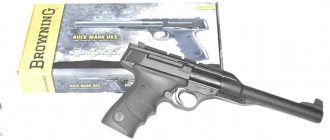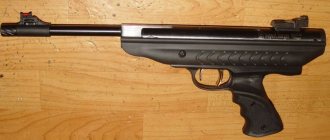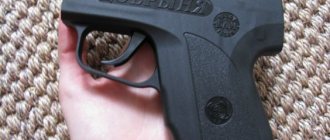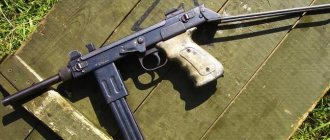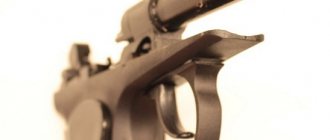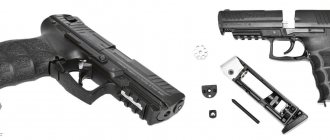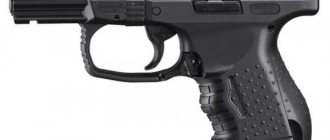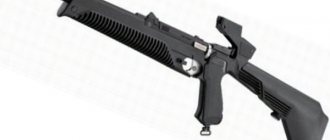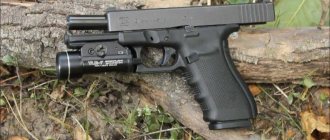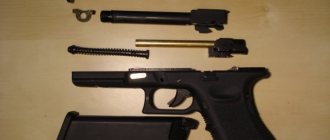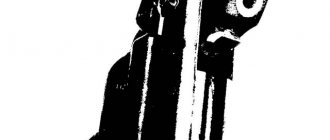Original store
The 11-place in-line magazine of the pistol is located, quite original, under the barrel of the pistol. The composition is similar to Cornet, but that one has a magazine on top, and here it has a magazine on the bottom. To load bullets into the Gamo P-23 Combat magazine, you need to press the barrel release button and tilt it forward, much like on the MP-512.
Loading a magazine with balls is not very convenient; the receiver in the Gamo P-23 Combat is not locked in the open position; only the bullet feeder is locked. It’s nice to be able to load a pistol, with an empty in-line magazine, with different bullets directly into the barrel, including darts of any length.
Pistol Wilson Combat CQB (USA)
Page 1 of 2
Pistolsmith Bill Wilson knows what a professional needs, having been a competitive pistol shooter himself for a long time.
Many champions won their awards with his weapon. Wilson's Gun Shop is the world's largest manufacturer of custom parts for M1911 pistols. Most gunsmiths who fill these jobs throughout the United States use Wilson parts to some degree. In addition, Wilson's Gun Shop itself produces similar products. The weapon, called the “ Wilson Combat CQB ” (Close Quarters Battle - “close quarters pistol”), is supplied in this modification to the most elite special forces of the US Army.
These pieces were produced in a limited edition of only 100 pieces with special numbers from DF00001 to DF00100. Wilson Combat CQB pistol is designed specifically for professionals. There is nothing superfluous in it. Every detail of it will serve in a moment of danger. The pistol does not have the commonplace trigger guard of a modified shape or with a notch on the front surface, a bolt stop lever or an oversized magazine release button. The total length of the pistol is 219 mm, height is 149 mm, width (in the handle) is 33 mm. Weight without cartridges - 1100 g. Fully loaded with nine cartridges, it weighs 1280 g.
The frame of the Wilson Combat CQB pistol is made from 4140 chrome-moly steel, lost wax casting and then milled. The rear pillar of the frame has a cutout for Wilson's automatic fuse. To make it easier to change the magazine, the entrance to the socket in the handle has corresponding bevels. The front surface of the handle has a notch (in increments of 1.3 mm). The Wilson bolt is machined from a forged 4140 steel and then hardened to HRC 39 for maximum strength and reliability. The ejection port is extended rearward to prevent case deformation during ejection and increase reliability of the pistol's automatic operation. The Wilson Combat CQB pistol's slide and frame are tuned to provide the best possible shooting accuracy without sacrificing reliability. Both the frame and the bolt, and all other parts, with the exception of the barrel, barrel sleeve, trigger, hammer, return and mainsprings, have a matte black phosphate coating. In addition, all sharp corners of the frame and bolt are rounded to make this weapon more convenient for concealed carry.
Wilson Combat CQB pistols of this small series there is an additional notch in front, through which the bolt is pulled to visually determine the presence of a cartridge in the chamber. Another distinctive feature is the pistol's markings. "Wilson Combat" is written on the left side of the slide, and the US Army Special Forces insignia is depicted on the right side behind the cocking serration. On the front on the same side is written “Special Ops CQB.” To install the rear sight and front sight, the bolt has dovetail grooves. The sights are non-adjustable, low-profile, non-tacky, with tritium dot inserts. One dot on the front sight shines green, and two on the rear sight shine yellow. The length of the aiming line is 170 mm.
Wilson's sport grade barrels are renowned for their high quality and inherent accuracy. The barrel is forged from 416 stainless steel to very tight tolerances. They are hardened to a hardness of HRC 38-42, after which the chamber is deployed, while achieving the highest concentricity with the bore. Wilson barrels chambered in .45 ACP have six right-hand rifling with a 406 mm (16 in) stroke. The barrel of the Wilson Combat CQB pistol was “opened” at the breech above the feed guides in the frame and polished to improve the feeding of cartridges with unusually shaped bullets. The Wilson barrel coupling is a sports type and is made of stainless steel to achieve maximum automatic operation reliability and wear resistance.
Wilson ejectors are popular with custom pistol builders everywhere, as on the original M1911 the ejector is the bottleneck and most extraction delays are due to ejector fatigue failure. Forged Wilson ejectors are hardened for optimum strength and durability. The Wilson Combat CQB ejector is polished and then hand-fitted.
Wilson Combat CQB pistol also features Wilson's "heavy duty" firing pin spring, which reduces the risk of accidental discharge if the pistol is dropped without compromising primer ignition reliability. Wilson himself recommends changing the firing pin spring every five thousand shots. To fire powerful cartridges, the Wilson Combat CQB pistol is equipped with a recoil spring that provides a maximum force of 8.4 kg. The Wilson recoil spring is made from the finest, strongest steel to ensure smooth, smooth firing and reliable ignition of the primer. A Wilson buffer is installed on the return spring guide rod. This 2.5mm thick injection molded blue glass-filled polymer buffer prevents the bolt from hitting the frame during recoil. It must be changed every thousand shots. The buffer significantly increases the life of the shutter and frame.
<< First < Previous 1 Next > Last >>
Fuse
The Gamo P-23 Combat air pistol is equipped with a two-position non-automatic safety lever located on the left side of the pistol under the barrel, almost at the muzzle. This arrangement of the safety makes me think of the immeasurably long thumbs of the Spaniards, because I can only switch the safety with my second hand, which is somewhat strange for a pistol.
Accuracy
Despite the fact that the owners claim the accuracy of this device, having shot three magazines, I can say with confidence that the sample that came into my hands is, at a minimum, not accurate. The spread of bullets was about 10 centimeters when shooting from 7 meters in the room. At the same time, I failed to hit the center of the target. I think that the reason is a fairly tight trigger, which noticeably moves the pistol to the right at the moment the hammer is released from cocking. I would also like to note a certain imbalance in weight. The heavy barrel and receiver very noticeably pulls the pistol to the side, although it is not critical when holding it with two hands.
Specifications
| Caliber, mm: | 4,5 (.177) |
| Shot speed, m/s: | 120 |
| Magazine capacity: | 19 bullets |
| Weight, kg): | 0,928 |
| Energy Source: | CO2 canister 12g. |
| Bullet type: | BB balls cal. 4.5 mm |
| Guarantee: | 6 months |
| Manufacturer: | Umarex |
| Speed: | Gun 1: 117 m/s Gun 2: 115 m/s Gun 3: 110 m/s |
Price
What was also unpleasantly surprising was the price. When I first picked up the device, I boldly placed it in the category up to 3000, at the level of our Cornet. However, when I went to the store’s website before writing a review, I was surprised to find that this Gamo P-23 Combat air pistol is sold for 4,300 apiece. And this is without any BlowBack, pre-cocking, with a plastic body and, frankly speaking, rather flimsy insides in which metal parts, in friction, interact with plastic ones! The Spaniards raised the price, probably for the label.
I have the honor to present a relatively new, but already very common CO2 pistol on the Russian market. https://www.umarex.com/index.php?id=products&L=en&haupt_id=1&unter_id=1&variante_id=5.8096&cHash=b85fb8dee8
I would like to immediately clarify many disputes and dispel some misconceptions. 1. the pistol does not have a Blow-Back 2. it is completely metal, with the exception of the grip pads and the barrel clamp. 3. it is not made of steel, as they say in “Chance2003”
Now let's start looking at the new doll. I’ll make a reservation: be careful when choosing and try to immediately check with the cylinder; there have been cases of gas bleed through the valve. Fortunately, I bought at a trusted point from a trusted seller, who immediately equipped the cylinder and balls to test the functionality “without leaving the checkout.”
The pistol is packaged in a cardboard box similar to those in which Umareks PPK/S and CP99 Compact are packaged. The box contains a pistol and instructions.
Appearance. Externally, the pistol is very pleasant and to some extent even beautiful.
The weight is acceptable - not very light, but not very heavy either. The heaviest and most massive part is the store. The magazine is similar to the MP-654K magazine. The joint with the barrel is made through a gasket.The balls are fed by a spring feeder, the spring is quite tight. To charge the balls, the feeder is fixed in the lower position. The valve assembly is almost identical to the MP-654K (I suspect that even the gaskets from it can be adapted if necessary), accordingly, the upgrade methods are absolutely the same. The valve spring is soft, therefore it is possible that the valve does not fit tightly to the seat, which could hypothetically be the reason for the release of gas, which is observed on some samples.
The double-action trigger is equipped with a non-automatic safety lock that blocks the trigger and the bolt.
The trigger stroke is different depending on whether it is fired by self-cocking or from pre-cocking (with pre-cocking the swing is greater).
The “shutter” travel is very small; the shutter can be set to ZZ. When the bolt is retracted, the hammer is cocked
The rear sight can be adjusted vertically and horizontally using two screws.
There is an imitation of the muzzle of a combat pistol, but it is very unsuccessful.
Let's sort it out. Everything inside is quite neat and clean, although a foreign object was found:
To remove the bolt, you need to unscrew 2 screws in the rear part, after which the back stop will separate from it and the bolt will move forward.
Further, the entire structure is assembled mainly on pins. This thin tube is the trunk.
The barrel is smooth and steel.
Those who screwed a screw into the trigger of the Umarex Beretta 92FS should rejoice, there is already a steel insert:
As we can see, the striker does not move parallel to its axis, but around the axis of the holder. This design seems somewhat dubious to me, but time will tell. The drummer is pressed against the valve by a spring.
And here lives the mainspring. You can access it without disassembling the gun; just knock out the pin at the bottom of the handle.
What’s interesting is that absolutely all the details are numbered.
About materials. The pistol is almost entirely made of silumin, only the screws, self-tapping screws, barrel, springs, pins, trigger rod, firing pin, insert in the trigger hitting the firing pin, and valve stem are made of steel. The shutter is made of aluminum, so it is very light in weight. the side edges of the shutter, imitating stainless steel, are actually unpainted parts. Apparently, the choice of material is explained by the decorative design. The handle pads and the clamp holding the barrel in the silumin false barrel are made of plastic
Overall, the pistol left a positive impression and, given its low price, will probably find its place in Airgun collections. The description is still somewhat superficial, but I only bought the gun today, so I’ll add more as I pick it up.
If you have any questions, I'll be glad to try to answer them.
